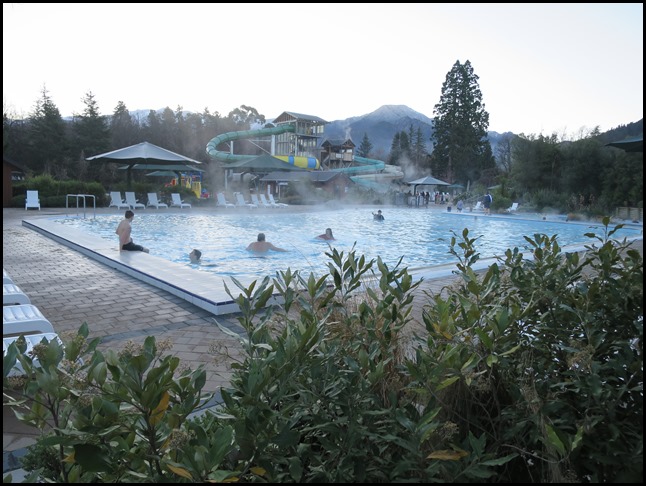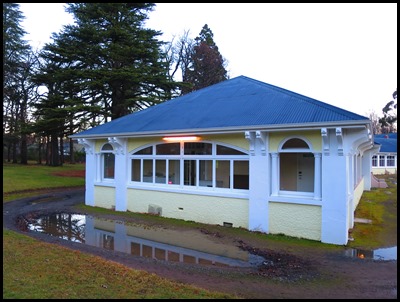Queen Mary Hospital

|
Queen Mary Hospital, Hamner
Springs.
 We left Mabel and bimbled in the
direction of the thermal springs to reconnoitre for the morrows hot soak, still
bothered that once hot, I will have to stand up in freezing air and pretend not
to be cold. As we neared our target, we saw a green
sign for the Queen Mary Hospital that said visitors welcome.
In we went. We could see from the site map the footprint of the grounds was pretty big,
but nothing could have prepared us for the surprise of
it all, the fact that the buildings, although needing much TLC were
not in that bad a condition.
 Our first
look.
The
Queen Mary Hospital played a role in the lives and wellbeing of many New
Zealanders. It was established in Hanmer Springs in recognition of the benefits
of the thermal springs as well as the healing qualities of the alpine
environment. The area around the hot springs including the Queen May Hospital
grounds was proclaimed a reserve in 1860 and became nationally recognised as a
government spa resort after baths were built in the 1880’s. Development of the
grounds commenced around the same time with extensive tree planting and a later
focus on ornamental garden beds.

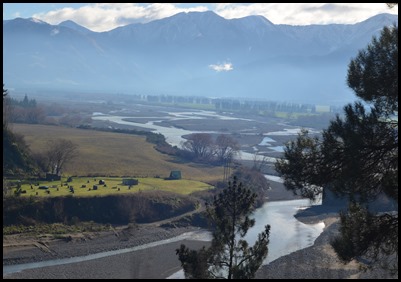 Maori on ara pounamu (greenstone trails) were the first to enjoy the thermal water, as a rest stop on the long journey to the West Coast. The first known European discovery of the thermal area was in April 1859 by William Jones, a farm manager from Culverden, who was drawn to what appeared to be "a remarkable fog". The village was named after Thomas Hanmer an early settler. Early development was hindered by inaccessibility, the first Waiau Ferry Bridge blew down in a strong nor’wester and wasn’t replaced until 1874. Our view as we crossed the bridge today, so much haze in front of the mountains. In 1879 an iron bathing shed set up on the site and a manager appointed and the first proper swimming pools were dug. A bathhouse was created in 1883. Invalids and injured servicemen have enjoyed the curative mineral waters. In 1902 the Government planted a wide variety of introduced trees at Hanmer Springs as an experiment for New Zealand’s fledging plantation logging industry. Today, Hanmer Forest is unique in New Zealand as a near-natural woodland of European trees.
While, from the outset the thermal pools were used for recreational swimming, they were early recognised for health rehabilitation. Treatment included both swimming in and drinking of the thermal waters. A Sanatorium was opened in 1897 to accommodate visitors of fragile health who were taking the waters, this building burnt down in 1914, the day after World War One was declared. In its stead, the Queen Mary Hospital for Sick and Wounded Soldiers – Soldiers’ Block, was opened in 1916 as a military hospital to treat shell-shocked servicemen. This was followed by facilities to treat women with nervous disorders in 1926 – Chisholm Ward. From 1928, the now predominantly female staff was housed in the Nurses’ Hostel. The Soldiers’ Block was upgraded during World War Two to again care for returning servicemen. In 1960 the control of the Queen Mary Hospital was transferred to the Hospital Division of Mental Hygiene for the treatment of alcohol and drug dependency. The Queen Mary Hospital finally closed in 2003 when government funding was withdrawn. In 2010, as a result of community and Council efforts to protect the site, 5.3 hectares and three nationally significant buildings were vested in the Hurunui District Council to be managed as an historic reserve. 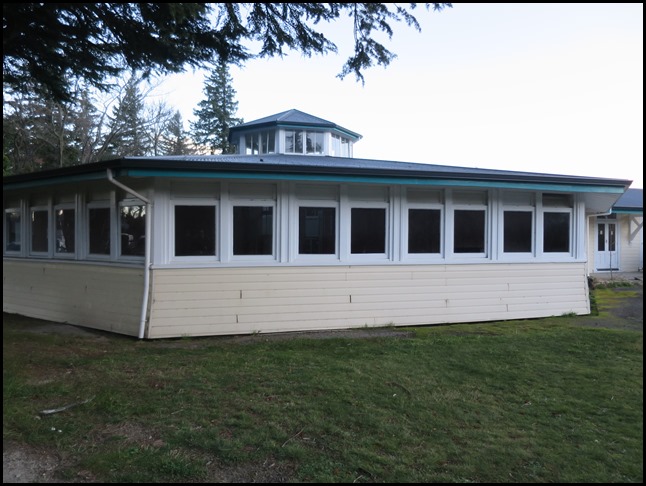 The Soldiers
Block.
As we approached the building it
looked in perfectly good repair and we expected to see people bimbling around,
as we got closer it was sadly clear this was a very abandoned place. In 1914
Duncan Rutherford offered The Lodge Hotel for use as a convalescent home under
military command for the treatment of shell-shocked servicemen. The success of
the temporary home confirmed the value of an association with the special
healing qualities of the thermal pools and was a prime factor in the choice of
Hamner Springs for the South Island Military Hospital. This led to the
construction of the specially designed Queen Mary Hospital for Sick and Wounded
Soldiers on the Government Sanatorium site in the Thermal Reserve.
 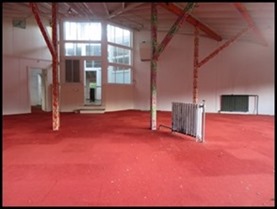  Then and
now.
The building was designed to maximise
the benefits of fresh air and sunlight and holds national significance as one of
the only two remaining hospital buildings of this design and the only one
remaining on its original site. The hospital remained under military control
until 1921 when it was handed over to the Department of Health with Dr. Chisholm
– formerly Lt. Colonel, continuing as the Medical Superintendent.
Like its sister hospital in Rotorua,
the ward accommodated two hundred sufferers of shell shock and neurasthenia in
two octagonal rooms connected by a corridor. Features of the rooms were a
central nurses station and a lantern roof designed to let fresh air and sunlight
into the ward. The gardens feature rhododendrons and azaleas thought to be over
a hundred years old.The hospital treated patients with hypertension and
anxiety as well as some joint disabilities. From 1943, the hospital focused on
treating functional nervous diseases, and from around this time also became
involved in treating alcoholics. At the end of this building we could clearly
see into the modern Spa.
This is what I have to brave tomorrow.
I don’t mind the getting in, being warm and trying the hot
pools, even the sulphur pools, it’s the standing up in the biting
cold........
  Nursing
staff 1933. The Hostel lawn in 1950.
The original nursing staff were male
and lived in the village. When the treatment of women patients began more
suitable living conditions were required for female staff. The building type is
rare nowadays but continues a four hundred year old tradition of the use of
Georgian style for a hospital building. The Hostel provided fifty six single
rooms with shared bathroom facilities. Adjacent kitchen was the large south-west
corner where a terrace gave access to the grounds. A variety of communal living
spaces opened out to the west where the attractive and spacious outdoor area was
an important feature of the environment to create homely conditions for the
nurses.
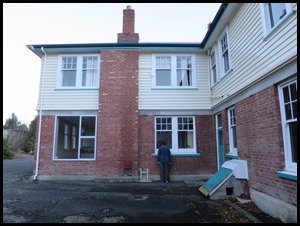  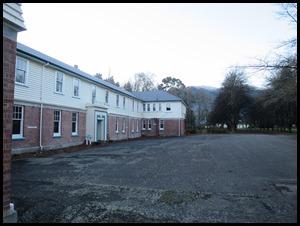 Today. Bear
looking in the kitchen window. The kitchen still had
plates stacked by the sink and looking from the kitchen to the far end of the Hostel.
  Two of the sad
entrances.
 At the far end of the Nurses Hostel we found a lovely orchard. We could see the
final building off in the distance.
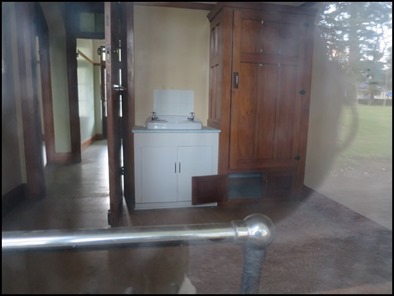  We walked over to
the last building and worked our way past many rooms, all with sinks and cupboards until the last one which was
a bright and airy kitchen.
 Then we saw the building from the front. What a
wow.
 We had crossed the
site and now stood by Jacks Pass
Road.
 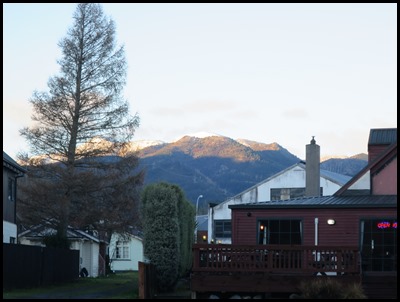 Very chic hotels with an amazing
backdrop.
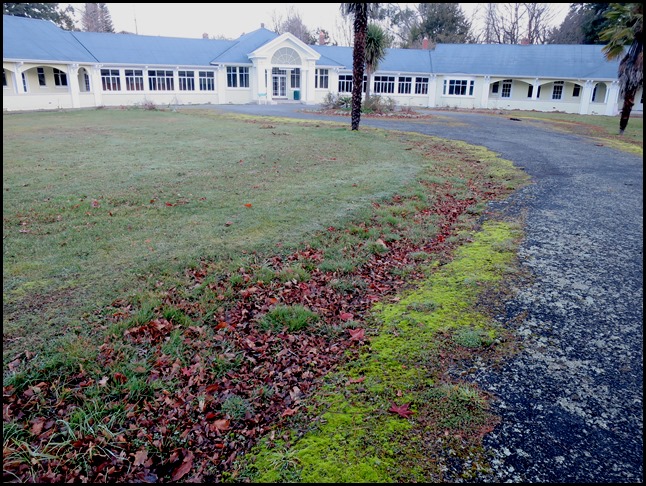 Back to the main door, where we could see another green
sign.
  The building of a
large block to house female patients suffering functional nervous diseases
represented a phase in the hospital’s development from a military facility to a
specialist complex for the general public. This became known as the Chisholm
Ward in honour of the long-serving Medical Superintendent Dr. Percy Chisholm.
The building was designed in the Arts and Craft Movement style with an
architectural approach taken to health promotion providing access to fresh air,
sun and a calming landscape as essential elements. A belief that women patients
should be afforded more privacy resulted in a much cosier setting than the
military hospital built ten years earlier with mostly single rooms, each with
their own washbasin, being provided. The building outlook was planned to enhance
the therapeutic environment with beautiful views over expansive lawns and
gardens to the mountains beyond. Later an internationally
recognised facility for the treatment of drug and alcohol dependencies up until
2003.
 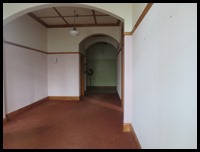  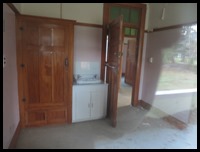 Bear on the front verandah and
looking through some windows.
   Although mid-winter, the garden still looks well tended and neat.
 The view from the front door cannot
be argued with.
As the automatic lighting came on we bade this amazing place ‘farewell’ and wish it luck. ALL IN ALL SUCH A
SHAME
AN UNEXPECTED AND UNUSUAL
FIND |


